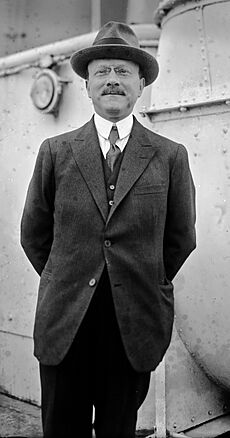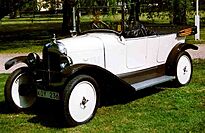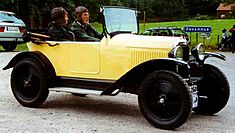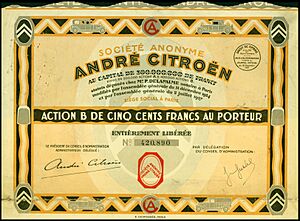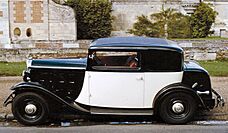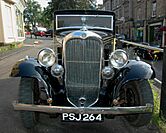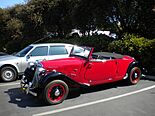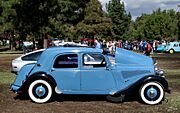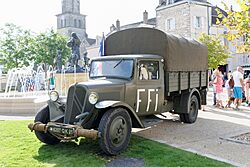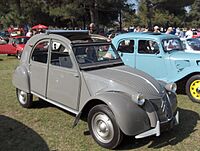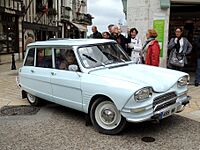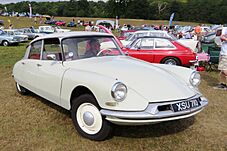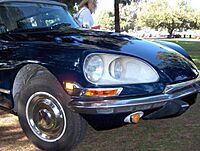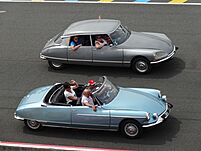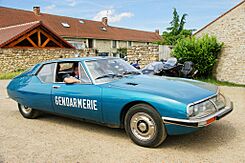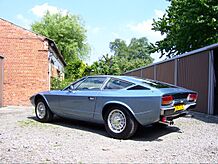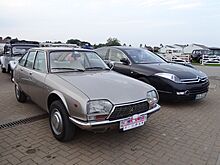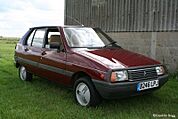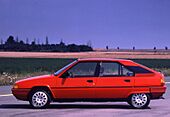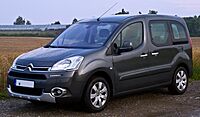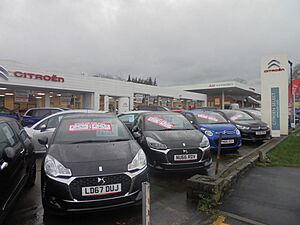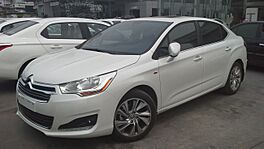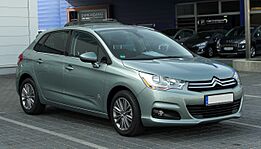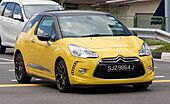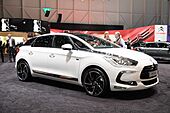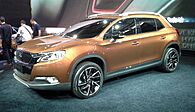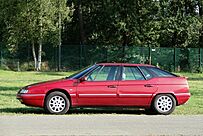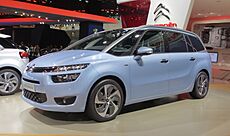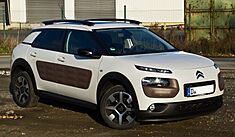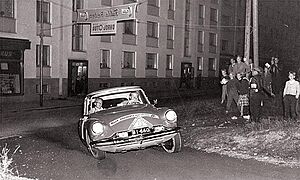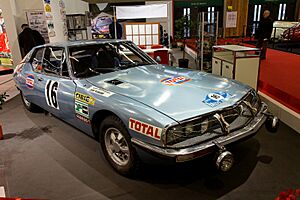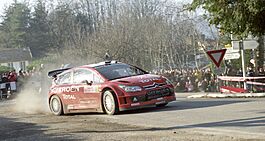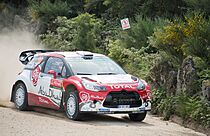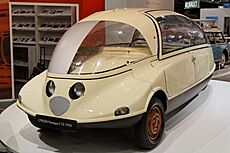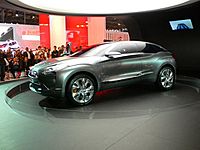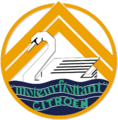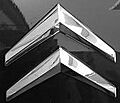Citroën facts for kids

Logo since 2022
|
|
| Subsidiary | |
| Industry | Automotive |
| Fate | Merged with Peugeot to form PSA Group in 1976 |
| Founded | 4 June 1919 |
| Founder | André Citroën |
| Headquarters |
Poissy (New), Saint-Ouen-sur-Seine
,
France
|
|
Area served
|
Worldwide (except North America) |
|
Key people
|
Antonio Filosa (CEO, Stellantis) Xavier Chardon (CEO, Citroën) (since the 2nd of June 2025) |
| Products |
|
| Services | Citroën Insurance |
|
Number of employees
|
13,900 |
| Parent | Stellantis |
Citroën is a famous French car brand. The company, "Automobiles Citroën," was started on June 4, 1919, by André Citroën. Today, Citroën is owned by Stellantis, a big car group. Before that, it was part of the PSA Group after Peugeot bought most of its shares in 1976. Citroën's main office is in Poissy, France.
Citroën became known for its amazing new technology. In 1934, they made the Traction Avant. This was the first car made in large numbers with front-wheel drive and a special body that didn't need a separate frame. This made cars lighter and stronger.
Later, in 1954, Citroën created the world's first hydropneumatic self-levelling suspension system. This system kept the car level no matter how many people or how much cargo it carried. Then, in 1955, they launched the revolutionary DS. This car was the first mass-produced car with modern disc brakes. In 1967, some models even got swiveling headlights that turned with the steering wheel, helping drivers see better on curvy roads. These cars have won many awards for their clever designs.
Contents
- History of Citroën Cars
- Advertising and Awards
- Motorsport Racing
- Concept Cars
- Citroën Logo
- Factories Around the World
- International Markets
- Current Car Models
- See also
History of Citroën Cars
How André Citroën Started
André Citroën finished engineering school in 1900. After his mother passed away, he visited Poland, her home country. There, he saw a carpenter using special gears that looked like fishbones. These gears were quieter and worked better. André bought the idea, which led to his invention of double helical gears. The next year, he used his inheritance to start "Citroën, Hinstin et Cie," a company that made these special V-shaped gears.
Before World War I, Citroën worked with another car company called Mors. During the war, he built weapons for France. But he was smart and realized that after the war, his factory would be modern but without a product. So, he started planning to make cars.
Making Cars for Everyone
By 1916, André Citroën decided to make cars. He wanted to build a light, good-quality car that many people could afford, much like Henry Ford did in America. In 1917, he asked engineer Jules Salomon to design a 10-horsepower car. It had to be better equipped, stronger, and cheaper than any other car at the time.
The result was the Citroën Type A. It was shown to the public in March 1919, just a few months after the war ended. The first Type A cars were made in Paris by May 1919. In June, they were displayed at a showroom on the Champs-Élysées, a famous street in Paris. This showroom, called C42, is still used by Citroën today for showing off their cars. The first customer bought a Type A on July 7, 1919. That year, Citroën made 30 cars a day, and by 1920, they had made over 12,000 cars.
Around this time, André Citroën almost sold his company to General Motors. But the deal didn't happen, and Citroën stayed independent until 1935.
Between 1921 and 1937, Citroën also made special half-track vehicles for off-road use and the military. These vehicles used the Kégresse track system. The U.S. Army even bought some and later made their own versions, like the M2 Half Track Car and M3 Half-track. After France was occupied in 1940, the Nazis took many of these Citroën half-tracks and used them.
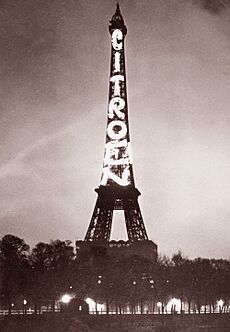
André Citroën was also a master of advertising. He used the Eiffel Tower as the world's largest advertising sign! He also sponsored big expeditions across Asia, North America, and Africa. These trips showed how well his half-track vehicles could travel through tough areas, carrying scientists and journalists.
In 1923, a Citroën car that had already traveled 48,000 kilometers became the first car to be driven all the way around Australia. This car, a 1923 Citroën 5CV Type C Torpedo, is now fully restored and in a museum.
In 1924, Citroën started working with American engineer Edward G. Budd. Budd had developed steel bodies for trains. At the Paris Motor Show in October 1924, Citroën showed the Citroën Type B10, the first car in Europe with an all-steel body. These cars sold well at first, but competitors soon made new designs with wooden frames. Citroën didn't update his car bodies, but still sold many cars because they were cheap. However, this caused the company to lose a lot of money.
In 1927, the bank Lazard helped Citroën with money and by managing its debts. André Citroën realized he needed to make his cars stand out. In 1933, he introduced the Rosalie, the first passenger car sold to the public with a diesel engine.
The Traction Avant and Michelin Takes Over
The Amazing Traction Avant
The Traction Avant was a groundbreaking car. It was one of the first cars made in large numbers with three new features still used today: a unibody (meaning the body is the main structure, not a separate frame), independent suspension on all four wheels, and front-wheel drive. For many years, most cars were built like the Ford Model T, with a body bolted onto a frame. The Traction Avant changed how cars were built, making them lighter and better to drive. In 1934, Citroën asked the American Budd Company to help create the Traction Avant.
Developing the Traction Avant, rebuilding the factory quickly, and spending a lot on advertising was very expensive for Citroën. This led to the company's financial problems. In December 1934, Citroën went bankrupt. Michelin, a tire company that was already Citroën's biggest lender, became its main owner. Even though Citroën faced financial trouble, the Traction Avant was a success. This car set the path for Citroën to keep using advanced technology to make its cars special. Pierre Michelin became the head of Citroën in 1935. Sadly, the founder André Citroën passed away in 1935.
Secret Research During Wartime
During World War II, when Germany occupied France, Citroën's researchers, including Paul Magès, secretly continued their work. They developed ideas for three amazing new vehicles: a small car called the (2CV), a delivery van called the (Type H), and a large family car called the (DS). These cars were seen as very advanced and unique. This secret work helped build a strong loyalty to the Citroën brand for many years.
The Popular 2CV
Citroën showed the Citroën 2CV, also known as the Deux Chevaux (meaning "two horses"), at the Paris Motor Show in 1948. This car became a huge success. It was designed to give people in rural France a motorized alternative to horses. It was very cheap to buy and run, with a small two-cylinder engine. The 2CV had a very soft, connected suspension. This car was made, with only small changes, until 1990. Over 9 million 2CVs were produced, and they were a common sight on French roads for a long time.
The Iconic DS
In 1955, Citroën launched the DS. This car fully used Citroën's special hydropneumatic self-levelling suspension system. The DS was also the first car made in large numbers to have modern disc brakes. The car used a single high-pressure hydraulic system for the power steering, suspension, and brakes. Even the gearshift was powered by this system, so there was no clutch pedal for the semi-automatic version. From 1968, the DS also had special driving lights that turned with the steering, making it easier to see at night. Almost 1.5 million DS cars were made between 1956 and 1975. The DS was known for its sleek design and its name. In French, "DS" sounds like "déesse," which means "goddess." It was ranked third in the 1999 Car of the Century competition.
High-Pressure Hydraulic System
Citroën's high-pressure hydraulic system was used in over 9 million cars, including the DS, SM, GS, CX, BX, XM, Xantia, C5, and C6. The main benefit was the Self-levelling suspension: the car always stayed at the same height above the road, no matter how much weight it carried. This system made the ride incredibly smooth, often compared to riding on a "magic carpet."
These cars would rise to their normal height when the engine was turned on, like a "mechanical camel." Drivers could also adjust the car's height using a lever, which was useful for clearing obstacles or changing tires.
Because Citroën didn't have a lot of money, their early cars sometimes had problems when they first came out. But over time, the hydraulic system became very reliable. Other car companies, like Rolls-Royce and Mercedes-Benz, later used similar suspension systems, showing how advanced Citroën's technology was.
Pioneer in Aerodynamics
Citroën was one of the first car makers to focus on aerodynamic design. This helps cars use less fuel and perform better at high speeds by reducing wind resistance. The DS, for example, could comfortably cruise at 160 kilometers per hour. Citroën started using a wind tunnel in the 1950s to design sleek cars. The CX model was so aerodynamic that its name came from the mathematical term for drag coefficient,  .
.
Growth and Challenges
In the 1960s, Citroën tried to grow by making new cars. However, these efforts were not enough, and Citroën faced financial trouble again in 1974.
The company had two main problems:
- They didn't have a mid-size car. Their range included very small, cheap cars (like the 2CV and Ami) and large, expensive ones (like the DS). The mid-size car market was the most profitable.
- They lacked powerful engines for cars sold outside France. French tax rules made large engines very expensive, so French cars often seemed less powerful in other countries.
To fix these issues, Citroën took several steps:
- In 1964, they partnered with NSU Motorenwerke to develop the Wankel engine, which could be powerful but small.
- In 1965, they bought the French car maker Panhard and the truck maker Berliet.
- In 1968, they bought the Italian sports car maker Maserati to get more powerful engines. This led to the 1970 SM, a powerful car with a Maserati engine and Citroën's hydraulic suspension.
- Also in 1968, Fiat bought a 49% share in Citroën.
The 1970s started well with the launch of the Citroën GS, a mid-size car with Hydropneumatic suspension. The GS sold 2.5 million units, helping Citroën become the second-largest car maker in France by sales volume in 1972. Older models like the DS and 2CV also continued to sell well.
However, things got worse. In 1973, Fiat sold its share back to Michelin. Then, the 1973 energy crisis hit, making cars with high fuel consumption less popular. Citroën's investments in the Wankel engine and Maserati also caused huge losses.
In 1974, Citroën stopped selling cars in North America because its cars didn't meet U.S. safety rules. The company's big losses from new models like the GS, CX, and SM, combined with the lack of a mid-range car for many years, led to another bankruptcy. Citroën had to sell Berliet and Maserati.
The PSA Peugeot Citroën Era
To save jobs and stabilize the company, the French government arranged for Citroën to merge with Peugeot. On June 24, 1974, Citroën announced this new partnership. In December 1974, Peugeot bought a large share of Citroën. By April 1976, Peugeot owned most of the company, creating the PSA Group (Peugeot Société Anonyme), which became PSA Peugeot Citroën. In May 1975, Maserati was sold to De Tomaso, and Berliet (the truck company) was sold to Renault.
The new PSA venture was successful from 1976 to 1979. Citroën had two popular new cars, the GS and CX. Sales of the 2CV and Dyane also went up after the oil crisis. Peugeot was careful with its money. However, when PSA bought Chrysler Europe in 1979, it led to losses from 1980 to 1985. PSA tried to revive the Talbot brand for the Chrysler cars, but stopped making them in 1987 because they were seen as unreliable.
At the 2019 Geneva International Motor Show, Citroën showed the Ami One concept car to celebrate its 100th birthday. In May 2019, they also showed the Citroën 19_19 Concept in Paris.
Changes in Car Design
Over the 1980s, PSA gradually made Citroën cars more like Peugeot cars. Citroën's unique and bold engineering style became less distinct. The 1982 BX still had the hydropneumatic suspension and a typical Citroën look. However, it used engines from Peugeot and shared its base with the Peugeot 405. This was part of a trend in the car industry called platform sharing, which helps reduce costs. By the late 1980s, many of Citroën's special features were changed or removed. While the cars became "more ordinary," they could also enter new markets.
Expanding Around the World
Citroën expanded into many new countries. Besides existing factories in Argentina, Chile, Vietnam, and Yugoslavia, they added Iran, Greece, Romania, and China.
In the late 1970s, Citroën developed a small car for Romania called the Oltcit. This car was sold in Western Europe as the Citroën Axel. That partnership has ended, but PSA and Toyota now make cars like the Citroën C1 in the Czech Republic.

The China joint venture started selling cars in 1984 and building them in 1994. The cars made there included the C3 and Xsara, as well as cars designed just for China like the Fukang and Elysée. By 2014, Citroën's sales in China had grown by 30%. The brand also ranked highest in China's 2014 JD Power customer satisfaction survey.
Citroën is a global brand, but it has not returned to North America since the SM was effectively banned in 1974 due to U.S. safety rules.
In 2015, Citroën Spain was fined over 14 million euros. This was because it worked with other car companies in a cartel that controlled 91% of the Spanish market between 2006 and 2013. They shared information about sales and repairs in a way that was not fair competition.
In 2016, Peugeot–Citroën South Africa (PCSA) stopped importing new Citroën models to focus on Peugeot sales. However, in May 2019, it was reported that Citroën would return to South Africa, which was confirmed in August 2019. New models went on sale there in October 2019.
Recent Years
From 2003 to 2010, Citroën made the C3 Pluriel, a unique convertible that reminded people of the old 2CV. In 2001, Citroën opened a museum called the Conservatoire with 300 of its important cars, celebrating its history of innovation.
After 2009, car sales in Europe dropped. Citroën's worldwide sales also went down from 1.46 million cars in 2010 to 1.43 million in 2011.
In 2011, the PSA Group almost partnered with BMW to develop electric and hybrid cars, but the talks failed. PSA then announced a partnership with GM, which also didn't work out. The Dongfeng Peugeot-Citroën joint venture in China continued to grow. By 2016, Citroën (and Peugeot) faced a challenge in China: they had too many sedans and hatchbacks, but not enough popular SUV and minivan models.
Despite financial difficulties for PSA Peugeot Citroën in 2014, the Citroën and DS brands worked on new technologies. However, sales for both brands in Europe and China fell by 22% by 2019, and even more during the 2020 COVID outbreak.
In January 2020, Linda Jackson was replaced as CEO of Citroën by Vincent Cobée.
Citroën entered the Indian market in early 2021 with the launch of the C5 Aircross SUV.
The DS Brand
In early 2009, Citroën announced a new premium brand called DS. This name stands for Different Spirit or Distinctive Series, and it also refers to the famous historical Citroën DS car. The slogan for DS cars is "Spirit of avant-garde."
The first car in this new series was the DS3, launched in 2010. It was a small car based on the new C3. The DS3 could be customized with different roof colors. It was named "Car of the Year" by Top Gear Magazine in 2010 and won "best supermini" four times in a row in a UK satisfaction survey. By 2013, the DS3 was the best-selling premium small car in Europe.
The DS series is closely linked to Citroën. The DS4 (launched in 2010) and the DS5 (launched in 2015) were based on Citroën concept cars. DS cars have a new DS logo instead of the Citroën double chevron, and they have very different styling from their sister cars. Citroën has also made some cool concept sports cars, like the Citroën Survolt, which was badged as a DS.
In China, Citroën has special DS showrooms and factories just for making these cars. Since 2014, Citroën has sold the Chinese-built DS 5LS and DS 6WR in China.
Advertising and Awards
Creative Advertising
Citroën was the first company to write in the sky with an airplane! On October 4, 1922, during the opening of the Auto Show, a plane wrote "Citroën" in smoke letters across the Paris sky.
Car Awards
Citroën has won many awards for its cars. In the 1999 Car of the Century competition, the Citroën DS was named the third most important car of the 20th century, after the Ford Model T and the BMC Mini.
Citroën cars have won the European Car of the Year award three times:
- 1971 – Citroën GS
- 1975 – Citroën CX
- 1990 – Citroën XM
The Citroën SM won the United States Motor Trend Car of the Year award in 1972. This was a big deal because this award usually only went to cars designed and built in the United States.
Citroën has also won the Auto Europa award eight times. This award is given by Italian automotive journalists to the best car produced in the European Union.
In 2023, Citroën won the 'Sustainability Initiative Award' at the Auto Trader New Cars Awards.
Motorsport Racing
Citroën Racing is the part of Citroën that handles its sports activities. They have been very successful in the World Rally Championship and the World Touring Car Championship. In 2019, Citroën announced it would stop competing in the World Rally Championship.
Early Rally Wins
Citroën cars started entering long-distance rally driving events in 1956 with the DS. The brand won many important races over decades with what was mostly the same production car design.
Racing the 2CV
Citroën found that while the slow 2CV wasn't good for racing against other cars, it was fun to watch them race against each other. Citroën Competitions sponsored three long-distance races for 2CVs: Paris-Kaboul-Paris in 1970, Paris-Persepolis-Paris in 1972, and Raid Afrique in 1973. Fans still continue this tradition with "2CV Cross," where 2CVs race around a dirt track.
Modern Rally Success
The Citroën Competitions division was affected by the company's bankruptcy in 1974. Rally racing also changed, moving from standard cars to specially built models. Citroën developed the Group B Citroën BX 4TC in 1986 to compete.
The team came back strong with the Citroën ZX Rally Raid. They won the Rally Raid Manufacturer's Championship five times (1993-1997). Citroën Racing also won the Dakar Rally four times (1991, 1994, 1995, and 1996).
From 2001, the Citroën Racing team was very successful in the World Rally Championship. They won the Manufacturer's Title eight times (2003, 2004, 2005, 2008, 2009, 2010, 2011, and 2012). The Citroën WRC Team driver Sébastien Loeb also won nine Drivers' Championships. He won with the Citroën Xsara WRC, Citroën C4 WRC, and Citroën DS3 WRC. The Citroën World Rally Team has a record of 97 victories in the World Rally Championship.
Touring Car Racing
In 2012, Citroën announced it would enter the World Touring Car Championship. They used a DS3 WRC as a test car, and its engine was an improved version of their WRC engine. Citroën developed a car for the new TC1 rules, which were introduced early in 2014. This gave Citroën a big head start over other car makers. With a large budget and strong drivers, Citroën was the favorite in 2014. They won most races that season and the manufacturers' title, and José María López won the drivers' title. They repeated this success in 2015 and 2016. The factory team left the series at the end of 2016, but other teams still raced Citroëns in 2017.
Concept Cars
Citroën has created many concept cars over the years. These cars show off future designs or technologies. Some famous concepts include the Citroën Karin (1980), Citroën Activa (1988), Citroën C-Métisse (2006), GT by Citroën (2008), and Citroën Survolt (2010).
Citroën Logo
The Citroën logo comes from a trip André Citroën made to Poland when he was 22. He saw a special chevron-shaped gear used in milling. He bought the patent for it. When two of these helical gears are put together in opposition, they cancel out forces. The two chevrons in the logo represent these two intermeshing gears. Early Citroën cars even used a similar gear system in their rear axle.
The logo's look has changed over time. Before World War II, it was yellow on a blue background. After the war, the chevrons became more subtle, usually on a white background. In the 1980s, the logo became white on red to look more dynamic.
On February 5, 2009, Citroën launched a new logo to celebrate its 90th anniversary. It was a 3D metallic version of the double chevron, with a new font for the name and the slogan "Créative Technologie." In October 2016, Citroën released a simpler 2D version of its logo. In 2022, the brand showed a new badge design that looks like its original 1919 logo, bringing back the oval shape around the two chevrons.
Logo Evolution
Citroën logos through history:
Factories Around the World
Citroën cars are made in many factories across different countries:
- Argentina (El Palomar): Berlingo
- Brazil (Porto Real): C4 Cactus, C3
- France (Mulhouse): DS 7
- France (Poissy): DS 3
- France (Rennes): C5 Aircross
- Portugal (Mangualde): Berlingo
- Slovakia (Trnava): C3
- Spain (Madrid): C4 Cactus
- Spain (Opel Zaragoza): C3 Aircross
- Spain (Vigo): Berlingo First, Berlingo, Xsara Picasso, C4 Picasso / C4 Grand Picasso, C-Elysee
- Turkey (Tofaş Bursa): Nemo (2007-2017)
Some Citroën models are also made in factories that are joint ventures with other companies:
- China (Shenzhen), Chang'an PSA joint venture: DS 5LS and DS 6WR
- China (Wuhan), Dongfeng Peugeot-Citroën Automobile joint venture: C-Elysee, C3 L, Xsara Picasso, C4 L, C5
- Czech Republic (Kolín), Toyota/PSA joint venture: C1
- France (Valenciennes), PSA/Fiat joint venture Sevel Nord: Jumpy/Dispatch
- India (Tiruvallur), PSA/CK Birla Group joint venture: C3, C3 Aircross, C5 Aircross, Basalt
- Indonesia (Purwakarta): ë-C3
- Italy (Val di Sangro), PSA/Fiat joint venture Sevel Sud: Jumper/Relay
- Japan (Mizushima), Mitsubishi Motors plant: C-Zero
- Russia (Kaluga), PSA/Mitsubishi joint venture: C4, C-Crosser
- Iran (Kashan), SAIPA Citroën JV: C3, C3xr, C4
- Turkey (Karsan): Berlingo
International Markets
Australia
Citroën has been in Australia since 1923, making it the country's longest continuously-running car manufacturer. However, in August 2024, the brand announced it would stop taking orders in Australia by November 1, 2024, because of slow sales.
Current Car Models
Citroën Models
DS Line Models
Dongfeng Peugeot-Citroën (Joint Venture) Models
See also
 In Spanish: Citroën para niños
In Spanish: Citroën para niños
- List of automobile manufacturers of France
- List of companies of France
- Lane departure warning system


